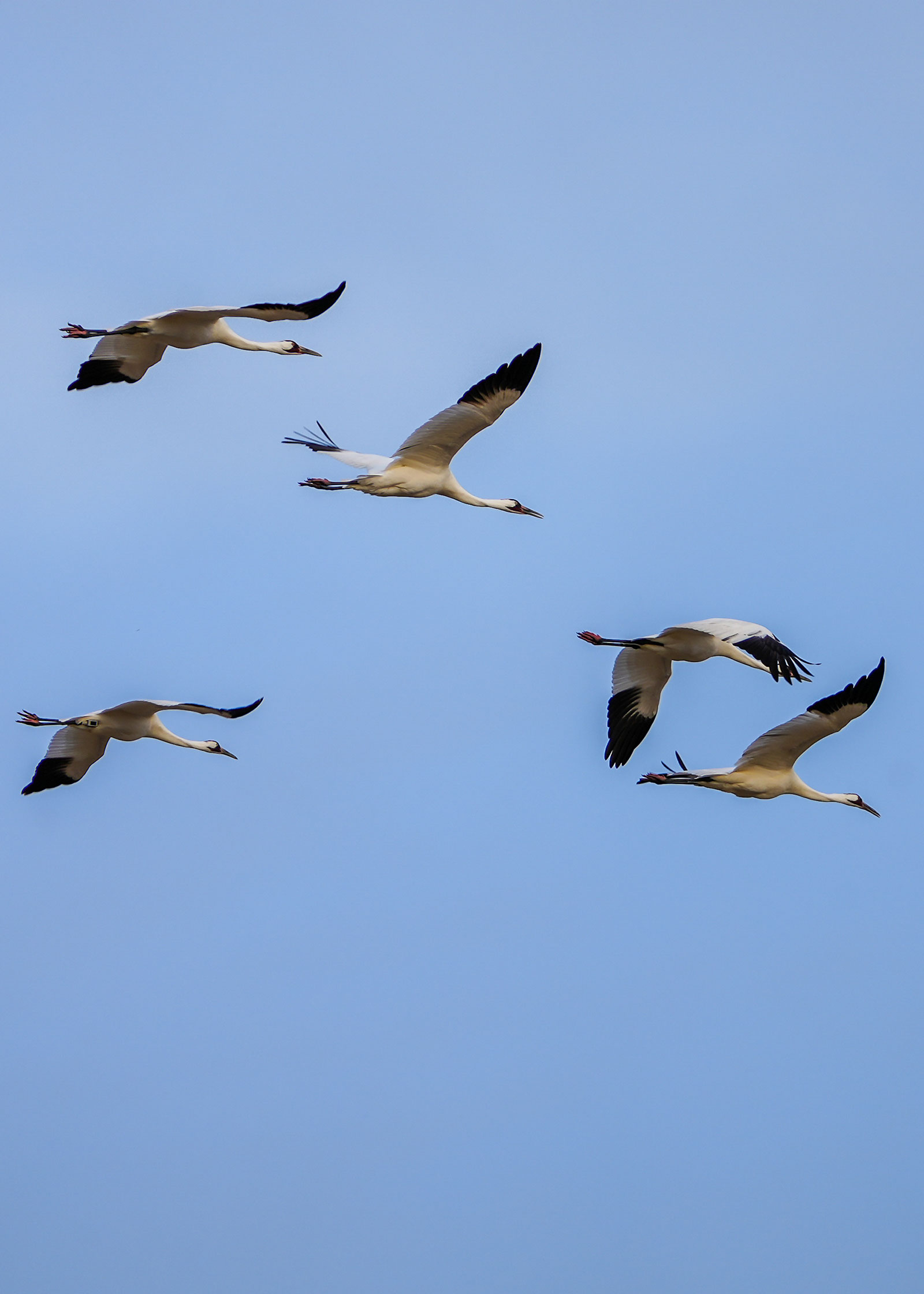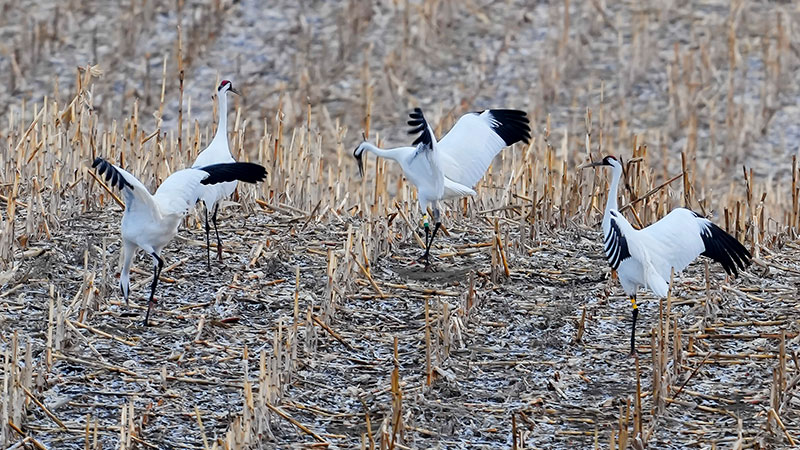Resting and Refueling in North Dakota
Ron Wilson

Two times a year North Dakota welcomes the arrival of what is arguably the rarest bird in North America. Yet, despite being heralded as the tallest of wading birds at nearly 5 feet, with a tip-to-tip wingspan of about 7 feet, its presence largely goes unnoticed by most.
Whooping cranes that utilize North Dakota as a stopover site to rest and refuel during spring and fall migrations, are part of the population that nests near Wood Buffalo National Park in Canada and winters around Aransas National Wildlife Refuge in Texas.
While the numbers vary, it’s been said that by 1941 there were just 20 or so cranes remaining in this migrant population. Today, following years-long conservation and recovery efforts, whooping crane numbers are impressive by comparison.
“During last year’s wintering ground survey on the coast of Texas, we actually had a record-high of 557 individuals,” said John Palarski, North Dakota Game and Fish Department migratory game bird management supervisor.
While the entire population doesn’t migrant as one, Palarski said the vast majority of the 500-plus cranes pass through North Dakota. And their 2,500-mile journey south to Texas is already underway.
“We start to see whooping cranes pop up in North Dakota sometime in October,” he said. “A lot of that migration, depending on weather, peaks around the end of October into early November. But they’ll stay in North Dakota as long as the conditions allow. Once it starts getting really cold and wetlands start freezing up, they’ll get out of here.”
North Dakota is located in what Palarski described as a huge migration corridor that the cranes utilize when heading north or south, depending on the time of year. Typically, the birds will spend more time in the state refueling during their southern fall migration compared to their spring journey in the other direction.

“North Dakotans, just throughout the migration in both the fall and spring, have a pretty unique opportunity to view them that most other people don’t have,” Palarski said of whooping cranes that were listed as endangered nearly six decades ago.
Aside from their notable height and impressive wingspan, whooping cranes are bright white with black wing tips and red patches on their crown and cheeks. In flight they extend their long necks, while their long, slender legs extend beyond the tail.
“While whooping cranes are a little bit awkward in flight, they’re still pretty charismatic,” Palarski said. “They’re a cool bird.”
From data gathered from whooping cranes that have been banded, Palarski said some of the birds are over 20 years old. One of the long-lived cranes is YAY, a frequent flier through North Dakota that is believed to be nearly 20.
YAY got her name because of the color combination — yellow, aluminum, yellow — of bands on her leg. Palarski said she was one of the first whooping cranes fitted with a GPS transmitter and the second whooping crane ever banded in 2009.
“A lot of our understanding of whooping cranes was derived from the data that she was able to provide us,” Palarski said. “Although her GPS transmitter has fallen off, she’s still banded. And we’ve seen her a few times moving through North Dakota both in the fall and in the spring over the last couple of years.”
YAY was observed last spring along the Missouri River System south of Bismarck.
“During the period her GPS transmitter was active (2009-13), YAY exhibited strong site fidelity south of Bismarck,” Palarski said. “She was among the first tagged whoopers to use the site as an extended stopover and continues to return.”
Palarski said anyone lucky enough to see any of these endangered birds during migration stopovers in North Dakota are asked to report the sightings so the birds can be tracked. Whooping crane sightings should be reported to the U.S. Fish and Wildlife Service offices at Lostwood, 701-848-2466; Audubon, 701-442-5474; and the North Dakota Game and Fish Department, 701-328-6300. Reports help biologists locate important crane habitat areas, monitor marked birds, determine survival and population numbers, and identify times and migration routes.
Palarski said for those spotting whooping cranes to observe them from a distance.
“One of the largest sources of mortality are whooping cranes actually colliding with manmade objects,” he said. “So, if folks are getting in close and inadvertently flushing birds, that drastically increases the probability that they’ll collide with something like a power line.”
Anyone sighting whoopers should, from a distance through binoculars, record the date, time, location and the birds’ activity. Observers should also look for and report colored bands which may occur on one or both legs. Whooping cranes have been marked with colored leg bands to help determine their identity.
Because whooping cranes can be associated with migrating sandhill cranes, hunters also need to be aware of their target.
“Whooping cranes commonly get confused with snow geese in some instances, pelicans and sandhill cranes too,” Palarski said. “The one difference obviously is their size, differentiating them amongst a lot of species. They are quite a bit bigger than a lot of sandhill cranes that we have migrating through the state.”

